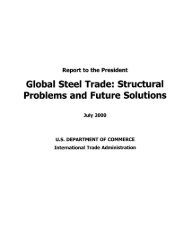Vietnam Environmental Technologies Export Market Plan
Vietnam Environmental Technologies Export Market Plan
Vietnam Environmental Technologies Export Market Plan
Create successful ePaper yourself
Turn your PDF publications into a flip-book with our unique Google optimized e-Paper software.
The recently completed Binh An Water Treatment<br />
plant supplies the HCMC Water Company with 95,000<br />
m 3 per day. The company pays a fixed price of $0.20 per<br />
m 3 on a take-or-pay basis. Meanwhile, the company can<br />
charge residential customers a maximum of $0.18 per m 3 .<br />
A second problem is the lack of accurate water meters.<br />
Installation of water meters is usually included in ODA<br />
or bilateral/multilateral projects to the water sector. In<br />
Hanoi, for example, over 70 percent of households lack<br />
water meters. Because of the poor distribution network,<br />
the water pressure is so low that meters cannot measure<br />
accurately. Water supply companies therefore charge a<br />
flat fee, resulting in overuse by some consumers and<br />
continuing losses for water companies.<br />
According to one estimate by the Hanoi Water Supply<br />
Company, households pay $0.43–$0.55 month, per<br />
person, for the equivalent of four cubic meters of water<br />
per person; $0.107 cents per cubic meter of water is well<br />
below prices recommended by multilateral donors<br />
funding water-supply projects in <strong>Vietnam</strong>.<br />
Table 4.1 Water Prices in <strong>Vietnam</strong>, per Cubic Meter<br />
Before After<br />
03/01/00 03/01/00<br />
Residential $0.09 $0.12 (1–4 m 3 )<br />
$0.18 (4–6 m 3 )<br />
Industrial $0.18 $0.23<br />
Luxury/Entertainment $0.29 $0.36<br />
Note: Prices are given in U.S. dollars.<br />
Source: Ho Chi Minh City Water Company.<br />
because HCMC’s primary water distribution network is<br />
unable to handle large volumes of water. HCMC Water<br />
Co. is unable to distribute at capacity because higher<br />
volumes will cause the old piping networks to crack.<br />
Another problem is the small diameter of many of the<br />
pipes in five key districts in HCMC—Districts 1 through<br />
5—pipe capacity needs to be expanded or rehabilitated<br />
so that the HCMC Water Co. can reach its customers.<br />
Ho Chi Minh City<br />
The water distribution network in Ho Chi Minh City<br />
(HCMC), much of it built during the French colonial<br />
period and not repaired since, is in desperate need of<br />
overhaul. Dilapidated pipe systems and weak water<br />
pressure have forced the HCMC Water Co. to use large<br />
water tanks to deliver clean water to many of HCMC’s<br />
districts.<br />
While BOT projects are lined up to supply HCMC with<br />
enough capacity to meet demand, the challenge will be<br />
efficiently distributing water to consumers. Therefore, if<br />
the two other BOT water-supply projects were to come<br />
on line, there would be no way to distribute the water,<br />
Hanoi<br />
Hanoi’s primary water distribution network is in better<br />
shape than Ho Chi Minh City’s. Its main system is a 330-<br />
kilometer-long network built in 1985 with funding from<br />
the Finnish Development Agency. This network meets<br />
European health standards and delivers water to over half<br />
a million customers. Hanoi has a second main distribution<br />
network, which is 217 kilometers long. This network,<br />
however, was built in the early 1900s by the French and<br />
needs rehabilitation.<br />
While HCMC’s biggest problems are leakage and the<br />
need to rehabilitate existing pipelines, Hanoi Water<br />
Supply Co. suffers from administrative weakness.<br />
Table 4.2 Industrial Water Demand Estimates for Industrial Estates and <strong>Export</strong> Processing Zones<br />
Size (in hectares)<br />
<strong>Export</strong> Annual Percent of<br />
Industrial Processing Water Total<br />
Location Estates Zones Total Demand* Demand<br />
Hanoi 1,700 760 2,460 0.492 8.4<br />
Haiphong 800 100 900 0.180 3.1<br />
Quang Ninh 200 100 300 0.060 1.0<br />
Quang Nam-Danang 1,010 470 1,480 0.2965.1<br />
HCMC 22,800 360 23,160 4.632 79.5<br />
Vung Tau 600 100 700 0.140 2.4<br />
Can Tho 150 150 0.030 0.5<br />
Total 27,110 2,040 29,050 5.830 100.0<br />
* Water demand is given in millions of cubic meters per year.<br />
Source: World Bank, <strong>Vietnam</strong> Water Resources Sector Review (May 1996).<br />
<strong>Vietnam</strong> <strong>Export</strong> <strong>Market</strong> <strong>Plan</strong><br />
17
















